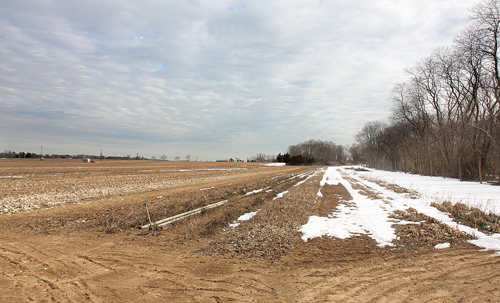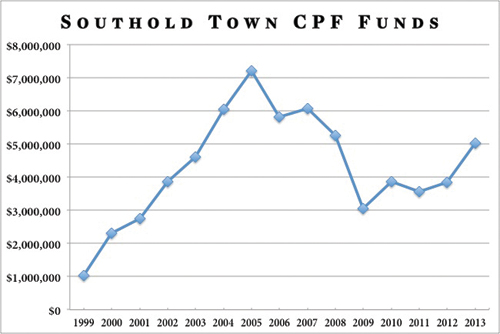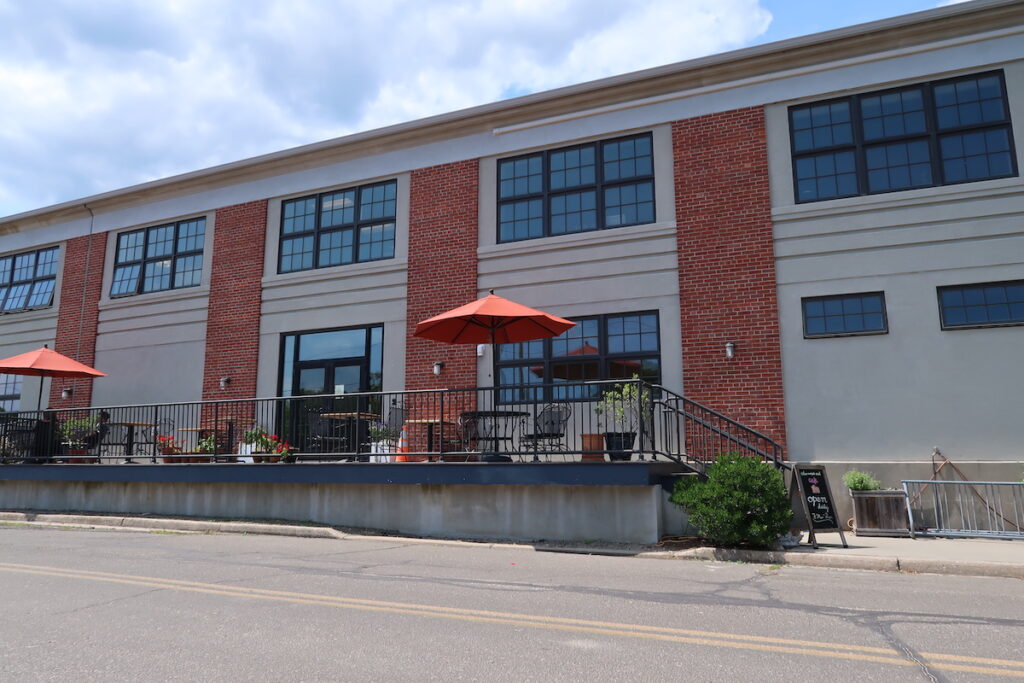Southold still ‘in the business’ of preserving farmland, open space

Southold Town’s Community Preservation Fund revenues climbed above the $5 million mark last year for the first time since the global recession sent real estate markets tumbling across the region in 2009.
The jump marks a 31 percent increase from the $3.8 million raised in 2012 and a 65 percent increase from 2009, when the fund took in about $3 million.
The Community Preservation Fund program, which began in 1999, uses money raised through a voter-approved 2 percent real estate transfer tax to buy open space and protect farmland. Each of the five East End towns operates its own fund, collecting money only from property transfers that occur within its own borders.
Southold officials stressed this week that thanks to careful spending and conservative borrowing against future CPF revenues, the town was able to purchase open space and farmland development rights — which restrict development on farmland in perpetuity — even during the lean years of 2009 to 2012. And unlike neighboring Riverhead Town, which borrowed so heavily against projected future revenues that it’s no longer making purchases, Southold Town is still “in the business of preserving land,” as Southold Supervisor Scott Russell put it.
“This seems to suggest there’s life in the real estate market,” Mr. Russell said. “The money’s coming in. It’s time to be optimistic, but it’s not a good time to start spending money on any [land] outside the priorities we’ve established and are operating under; they’ve served us well.”
Southold Town — like Riverhead and Shelter Island — receives only a fraction of the tens of millions in CPF funds collected each year by the two South Fork towns. (Southampton raised nearly $60 million in 2013, its best year yet.) But the town receives high praise from environmentalists and politicians alike over its handling of CPF money.
“I think the town has a good relationship with its farmers, so the town understands when the timing works best for the landowner,” said Richard Amper, executive director of the Long Island Pine Barrens Society. “Clearly it is the intent of the CPF to buy the land now, while it’s less expensive than it would be. But we’re not seeing that the town’s patience in acquiring land has resulted in land being developed that should have been preserved.”
Assemblyman Fred Thiele (I-Sag Harbor), who helped pen the initial state legislation that led to the fund’s creation, said Southold “would get an A” if he had to grade its performance on the CPF.
“They’ve been kind of the model program for the five towns,” Mr. Thiele said. “This is somewhat of a volatile revenue stream, depending on the market, and Southold’s done an excellent job on what to borrow and what to do on a pay-as-you-go basis.”

Southold Town has borrowed $22.5 million against future CPF revenues since 2008, through three separate bond issues authorized by the Town Board in 2007, according to numbers provided by the town. The board actually authorized $32.5 million in 2007, leaving $10 million still unissued.
The debt service for 2013 was about $1.6 million, an amount that will only drop down to about $1.5 million come 2030, which is the horizon to pay back CPF debt, and the year the entire program is scheduled to sunset, under the state law.
In 2011, Southold Town also adopted a fund service policy that keeps a specified amount of money set aside to ensure the town can pay its bills, no matter how real estate markets affect revenues.
“We need to anticipate that we weren’t always going to have the money coming in to pay the debt,” Mr. Russell said.
Bob DeLuca, president of Group for the East End, said one fly in the ointment of the higher CPF revenue news is that Suffolk County, which has partnered with Southold and Riverhead on many past land purchases, has borrowed so heavily against its land preservation revenues — which are generated through sales taxes — that there’s little money left annually to do much other than pay the county’s debt.
“It’s critically important to understand the county has essentially run out of money for land protection and the county has been a huge partner in acquisitions,” Mr. DeLuca said. “One thing that’s a concern of environmentalists is, how do you get the county program back to what it used to be? I do think there’s a need for new revenue sources here and I’d like to figure out how we do that. Something that’s not a burden but gets the job [of land protection] done.”
Mr. DeLuca said that, aside from cleaner water and other benefits, land protection carries with it long-term tax benefits for those living in less developed areas.
“It’s a fact,” he said. “The more developed you are, the more, usually, you’re paying in property taxes for the necessary services.”
Suffolk County Legislator Al Krupski (D-Cutchogue), who is also a former Southold Town Board member, said the county has indeed “maxed out its credit card.”
“I’m trying to get the county to focus its efforts and preserve the highest quality parcels we can, since there’s so little money,” Mr. Krupski said.
Mr. Krupski, who is a farmer and served as liaison to the land preservation committee during his time on the Town Board, had worked closely with the committee and the town’s longtime land preservation coordinator, Melissa Spiro, to prioritize the types of land the town wanted to preserve. And, if the town had a willing buyer, the next challenge would be to find partners, such as Suffolk County or the nonprofit Peconic Land Trust preservation group.
“While the town was always willing and glad to partner with the county over the year, we didn’t rely on the county,” Mr. Krupski said. “But probably our biggest decisions were policy decisions. Focusing on acquisition was a big decision to make, at a time when other towns were starting to spend money on stewardship. We decided as a town to pay every dime we could on preservation and, really, just let the next generation figure it out on [stewardship] programs. We have open space parcels where we don’t have any trails yet, which is fine. Some day there will be a demand for that, and there will be trails.
“The town’s been conservative and progressive at the same time,” he said.
In terms of recent CPF activity, the town purchased development rights on two farm properties last year, Ms. Spiro said.
Last May, the town purchased development rights on 15.7 acres north of Route 48, across from Lucas Ford, for $65,000 per acre, with the Peconic Land Trust then purchasing the protected land itself.
And in December, the town paid $60,000 per acre for the rights on 27 acres of farmland owned by Joseph Macari Jr. on the south side of Bergen Avenue in Mattituck.
The town officials said Southold has established policies that heavily favor purchasing properties that are contiguous with other blocks of preserved land.
Mr. Russell said those policies serve as sort of “informal rating system,” though no true priority list exists.
“The reality is that farms and houses don’t make good neighbors,” he said.
Mr. Krupski recalled the pressure the town was under in the years before the recession, when real estate prices were rising at an alarming rate.
“It was a wild ride,” he said. “And we were under a lot of pressure to borrow against future revenues and buy as much as we could. But the reality of land preservation is that it begins and ends with the property owner. You need to have willing sellers in order to have an effective program.”
Much of the work involved in finding willing sellers falls in Ms. Spiro’s lap.
“One of the things I always keep in mind is that most of the time these are very difficult decisions to make,” she said. “We’re talking about paying sometimes millions and restricting their property. It’s not simple. Some sell to us for legacy reasons; they believe in preservation. Some of the farmers need money to buy another piece. But the best thing to say is that our program is, ‘Here: We have funding.’
“Some people think our preservation has stopped,” she said, “but we’re there to work with the landowners.”







